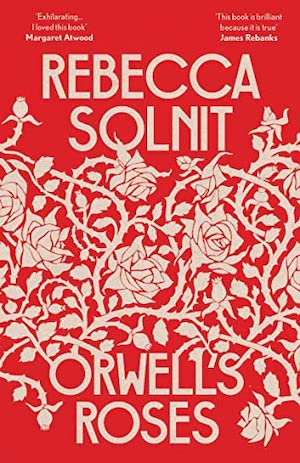Shortlisted for the 2022 Christian Gauss Award
By Allen D. Boyer
“In the spring of 1936, a writer planted roses.” With that crisp opening sentence, Rebecca Solnit looks back to an English garden in Wallington, a village south of Cambridge, where a struggling novelist had settled with his new wife. As plants, George Orwell’s roses were a ragtag bunch, bought at a Woolworth’s, randomly labeled, but sturdy and floriferous. As a metaphor—something that Solnit skillfully shapes and reshapes—Orwell’s roses prompt new attempts to understand his work and world.
Solnit acknowledges:
“I had not thought hard enough about those roses I had first read about more than a third of a century before. They were roses, and they were saboteurs of my own long acceptance of a conventional version of Orwell . . . . They were questions about who he was and who we were and where pleasure and beauty and hours with no quantifiable practical result fit into the life of someone, perhaps of anyone, who also cared about justice and truth and human rights and how to change the world.”
The insights to which Solnit follows Orwell and his roses are wide-ranging but never far-fetched.
V.S. Pritchett once remarked that Orwell was a man who had gone native in his own country. In Wallington, he was living in a thatched cottage, and (in the heart of a nation of shopkeepers) running a village store. Setting out roses and planting vegetables went with that. On gardening, Orwell could be as sentimental as a poet or as matter-of-fact as a market gardener. There was an emotional heft to his scornful comment that “the modern English literary world, at any rate the highbrow section of it, is a sort of poisonous jungle in which only weeds can flourish.”
Solnit opens new chapters by reworking her opening phrase. “In the year 1924, a woman photographed roses.” “In the year 1946, a dictator planted lemons, or rather ordered them planted.” The dictator was Stalin, “Orwell’s principal muse,” Solnit remarks, “the figure at the center of a terrifying authoritarianism wreathed in lies.” The woman who photographed roses was Tina Modotti. Known for her photography and her liaisons with Edward Weston and Diego Rivera, she saw hard service during the Spanish Civil War. While Orwell served in the trenches with anarchist militia, Modotti ran hospitals for the Communist International.
Solnit frames Modotti as Orwell’s mirror image. Her life counterpoints Orwell’s. We readily honor Orwell for defending traditional liberty; Modotti’s story confronts us with the story of an artist who just as fiercely fought for Stalinism. Similarly, Solnit takes a sidelong glance at Jamaica Kinkaid, who was bitterly exasperated with the English nation whom Orwell so lovingly praised. (And yet, Solnit succinctly notes, Kinkaid herself was a gardener who planted more than five thousand daffodils.)
Orwell’s affection for the natural world rhymes with early modern struggles against the enclosure of England’s common fields and the self-assertion of England’s common people. Solnit finds here a balance of ironies. Orwell’s family line ran back to a Scotsman who profited from slavery and plantations in Jamaica. Yet it also included a regicide, and an Elizabethan writer, Frances Neville, Baroness Bergavenny.
It is not only Orwell to whom his roses connect. His vulnerable, devoted wife, Eileen, who shared the dwelling in whose yard he dug and delved, also gets her due. Eileen worked in wartime for the Ministry of Food, which urged the English people to eat rose hips for the precious Vitamin C that they contained. Before the war, before her marriage, she might have seemed more promising than her husband: a woman from County Durham, who made her way to Oxford and London against the current of upper-class privilege.
The roses that Orwell planted endured. One was a pink rambler, a French hybrid Wichurana, Rosa “Albertine.” He saw it covering the garden fence with flowers in 1946; it was still flowering when Margaret Thatcher was prime minister. While visiting during a raw English autumn, Solnit saw “two big unruly rosebushes . . . one with pale pink buds opening up a little and another with almost salmon flowers with a golden-yellow rim at the base of each petal.” Orwell would have been cheered by that, and by the marvelous book that those flowers have inspired.
Allen D. Boyer (ΦBK, Vanderbilt University, 1977), a native of Oxford, Mississippi, lives and writes on Staten Island. Vanderbilt University is home to the Alpha of Tennessee Chapter of Phi Beta Kappa.




